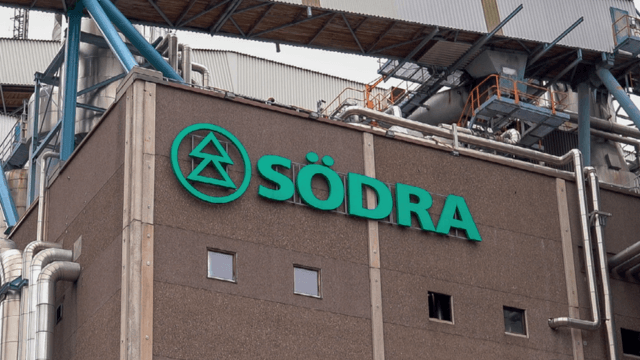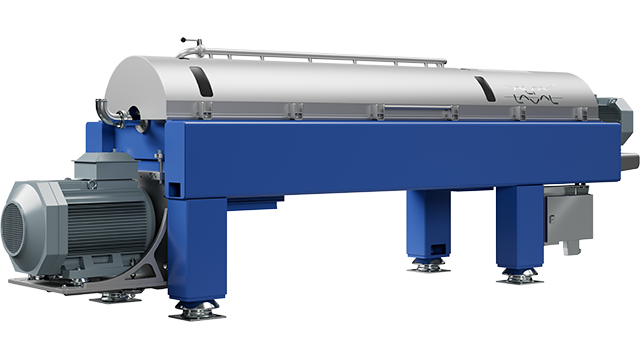Decanter centrifuges recover valuable chemicals from green liquor dregs
Compared to rotary vacuum drum filters (RVDF), using Alfa Laval decanter centrifuges to dewater green liquor dregs saves energy, space, time, and labour at the Södra Cell pulp plant in Mönsterås.
DATE 2025-10-12Södra Cell’s pulp mill in Mönsterås is one of the largest and most modern in the world, with an annual production capacity of 750,000 tonnes per year of softwood and hardwood pulp. In addition to pulp production, the mill is also an important source of green electricity and district heating, as well as pine oil for biodiesel. In 2020, the Mönsterås plant founded the world’s first commercial bio methanol plant, confirming its position as a significant provider of biofuels. To further enhance the mill’s sustainability profile, Södra Cell partnered with Valmet and Alfa Laval to overhaul its green liquor dewatering and chemical recovery systems, replacing its aging rotary vacuum drum filters (RVDF) with two decanters, to create a two-stage separation process. “Inorganics from the wood end up in the green liquor sludge,” explains Tord Hultberg, Project Manager at Södra Cell. “In the past, we used precoat drum filters to remove these substances, but the filters had a limited capacity and they were inefficient at recovering valuable minerals, such as sodium and sulphur.” A brief review of the dewatering process highlights the advantages that decanter centrifuges offer Södra Cell Mönsterås, compared to RVDFs:
Processing overview
Pulping wood chips requires white liquor, which is transformed into black liquor during the kraft pulping process. The black liquor is then treated in a multi-step process that recovers valuable chemicals and produces a new batch of white liquor. This recovery process includes channelling the black liquor through an evaporation system, and then incinerating it in a recovery boiler. The smelt from the recovery boiler is then mixed with weak wash process water to form green liquor, which consists primarily of sodium carbonate and sodium sulphide. The green liquor is subsequently mixed with calcium oxide to form white liquor, completing the cycle. Before being causticized, impurities in the green liquor are removed in a clarifier tank. The dregs from the tank are dewatered in a rotary vacuum drum filter (RVDF) or an Alfa Laval decanter centrifuge, before being sent for disposal.
Benefits of the decanter centrifuge
Using a decanter centrifuge instead of an RVDF offers a range of benefits, including lower operating costs, the possibility to dewater continuously, and a smaller physical footprint. In fact, a decanter centrifuge is approximately one-fifth the size of a comparable RVFD, freeing up valuable space for expansion or other operations. For Södra Cell Mönsterås, the advantages of switching from a drum filter to a dual-decanter centrifuge have been significant, including:
- High cake dryness and lower sludge disposal costs
- Higher chemical recovery
- Reduced maintenance
- They need no precoating, which increases equipment availability and reduces labour costs, compared with RVDFs
- Continuous, automatic operation
- No need for vacuum pumps, precoating systems, or other complex utility equipment
“Sustainability is very important to us,” says Olof Hellström, Sustainability Coordinator at Södra Cell. “Mitigating our impact on the climate and using resources efficiently are primary areas of focus in Södra’s sustainability strategy. After we installed decanters from Alfa Laval, our demand for make-up sodium dropped significantly. In the long term, we know this type of investment is good both for the company and for the environment.”
The Alfa Laval decanter centrifuge requires no special maintenance. After each cycle, the machine needs only to be flushed with hot water condensate, which is readily available in the plant. According to Robert Carlström, Global Technology Manager, Chemical Pulp Valmet, “Energy savings, the ability to recover valuable chemicals, and ease of use all contributed to Valmet’s choice of Alfa Laval centrifuges for the Mönsterås installation. We supply our customers with process solutions, re-builds, re-causticizing and other services for their pulp mills,” he continues. “Due to aging equipment and the need for environmentally friendly solutions, we’re seeing an increasing demand from the market for solutions like the one at Mönsterås. We supplied the process engineering, the installation, the commissioning, and the start up. And we chose Alfa Laval to supply the centrifuges.”
“A two-stage centrifuge process gives Södra Cell Mönsterås improved savings in terms of the recovery of process chemicals,” says Amol Chinchankar, Sr. Global Technology - Decanter Sales, BU Energy separation at Alfa Laval. “The sodium content of the disposed dregs is very low – less than 5 grams per tonne. So, the Alfa Laval Decanter centrifuges have helped Södra achieve their sustainability goals and clean-tech vision. They’ve set a great example of green liquor dregs dewatering for pulp and paper mills across the world.”
“Here in Mönsterås,” concludes Production Manager Carl-Johan Roos “We continually develop our processes to be better, more effective, and more environmentally friendly. Installing our two centrifuges, with the help of Valmet and Alfa Laval, has turned out really great.”


